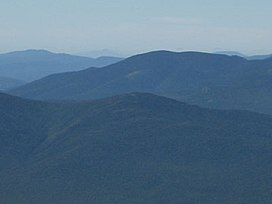| Mount Tom | |
|---|---|
 Mt. Tom (lower center) as seen from Mt. Jefferson | |
| Highest point | |
| Elevation | 4,051 ft (1,235 m)[1] |
| Prominence | 331 ft (101 m)[1] |
| Listing | White Mountain 4000-Footers |
| Coordinates | 44°12′37″N 71°26′45″W / 44.2103432°N 71.4459112°W[2] |
| Geography | |
| Location | Grafton County, New Hampshire, U.S. |
| Parent range | Willey Range |
| Topo map | USGS Crawford Notch |
| Climbing | |
| Easiest route | Hike Avalon Trail to A-Z Trail to Mt. Tom Spur |
Mount Tom is a mountain located in Grafton County, New Hampshire, about 1.5 miles (2.4 km) southwest of the height of land of Crawford Notch.
The mountain is named after Thomas Crawford,[3] whose family ran three inns in Crawford Notch in the first half of the nineteenth century. Mount Tom is part of the Willey Range of the White Mountains. Tom is flanked to the south by Mount Field. Mt. Tom is drained on the east by Crawford Brook and on the west by the Zealand River. Both are tributaries of the Ammonoosuc River, which drains into the Connecticut and thence into Long Island Sound.
From 1829 until about 1850, Tom Crawford was the innkeeper at the Notch House, which was located at the top of the Notch. Around 1850, Tom Crawford started to build a larger hotel and ran into financial difficulty. Forced to sell out, he left the Notch at that time. The hotel he started became the Crawford House.
An alpine ski area associated with Tom Corcoran and the Crawford House was proposed for the northern slope of the mountain in the early 1970s.[4]
See also[edit]
References[edit]
- ^ a b "Mount Tom, New Hampshire". Peakbagger.com. Retrieved 2013-02-22.
- ^ "Mount Tom". Geographic Names Information System. United States Geological Survey, United States Department of the Interior. Retrieved 2013-02-22.
- ^ Cenkl, Pavel (2009). This Vast Book of Nature: Writing the Landscape of New Hampshire's White Mountains, 1784-1911. University of Iowa Press. pp. 46–47. ISBN 978-1-58729-714-4.
- ^ New England Ski History: Cancelled Ski Areas, Mt. Tom
External links[edit]
- "Hiking Mount Tom". Appalachian Mountain Club.
- "Mt. Tom". HikeTheWhites.com.
- "Mt. Tom". FranklinSites.com Hiking Guide.
- "Mt. Tom:. New Hampshire Cancelled Ski Areas. NewEnglandSkiHistory.com.
Well, that’s interesting to know that Psilotum nudum are known as whisk ferns. Psilotum nudum is the commoner species of the two. While the P. flaccidum is a rare species and is found in the tropical islands. Both the species are usually epiphytic in habit and grow upon tree ferns. These species may also be terrestrial and grow in humus or in the crevices of the rocks.
View the detailed Guide of Psilotum nudum: Detailed Study Of Psilotum Nudum (Whisk Fern), Classification, Anatomy, Reproduction